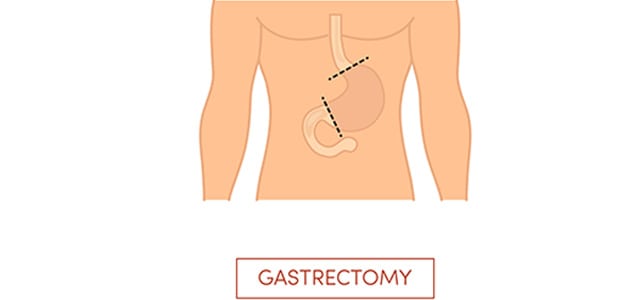
Maintain a healthy weight with the Sleeve Gastrectomy.
A revolutionary type of weight loss surgery, laparoscopic sleeve gastrectomy is a procedure that reduces the size of the stomach. As with other types of surgery for weight loss, patients will be encouraged to make changes to diet and overall lifestyle to improve the odds of enjoying long-term results.
- It’s a restrictive approach for weight loss surgery where about 80 percent of the stomach is removed in order to reduce the number of calories consumed from food.
- As a result of an intake of fewer calories, weight is lost.
CONTACT US TODAY
How It Works
During a laparoscopic sleeve gastrectomy, the stomach is divided vertically to create a pouch, or sleeve, about the size and shape of a banana. A laparoscopic sleeve gastrectomy is a less invasive approach to weight loss performed with a series of small incisions in the abdomen. A small camera attached to a tube (laparoscope) provides visual guidance for the surgeon. Special instruments are placed through the small incisions to make the necessary adjustments to the size of the stomach. Intestines remain untouched as approximately 75 to 80 percent of the stomach is removed.
Why It’s Done
A sleeve gastrectomy may be performed as a stand-alone procedure or as an initial procedure prior to undergoing a gastric bypass. This type of surgery may be recommended when other methods of weight loss are ineffective for a patient, the basic requirement for any type of surgical weight loss. It may also be done when a patient has a significant amount of weight to lose or if other surgical weight loss procedures aren’t likely to produce the desired results.

Who’s a Candidate?
A sleeve gastrectomy is a weight loss procedure meant for people are at least a hundred pounds beyond their ideal weight. Individuals with a body mass index (BMI) of 40 to 60 or more are also typically considered good candidates for laparoscopic sleeve gastrectomy. Patients may be considered with a slightly lower BMI if they have at least two weight-related health issues. Patients may also prefer this procedure if they do not wish to have a foreign body placed within the body, as is the case with gastric band surgery.
Possible Benefits *
A sleeve gastrectomy promotes weight loss by physically reducing the size of the stomach. Having a smaller stomach means only a small amount of food can be consumed at any given time. Patients often learn to recognize signs of being full to avoid overeating. Removal of part of the stomach also results in hormonal changes that can naturally reduce hunger urges. Losing significant weight with laparoscopic sleeve gastrectomy may also reduce health issues related to weight, such as high blood pressure, respiratory problems, and diabetes. Patients often benefit from:
- An average weight loss exceeding 50 percent of initial excess body weight
- Average weight loss maintenance of 50 percent or more
- Preserved stomach functioning, since nerves of the stomach are not affected
- Fewer issues with nutritional deficiencies since the digestive path isn’t changed
Keep in mind that results vary from one patient to the next.
Preparing for Laparoscopic Sleeve Gastrectomy
If a patient is excessively overweight prior to having a laparoscopic sleeve gastrectomy, they may be asked to lose some weight prior to having the surgery. Patients are sometimes referred to a nutritionist or dietician to learn what dietary changes they will need to make after the surgery. It’s also important for patients to have realistic expectations before having any type of weight loss surgery.
Life After Laparoscopic Sleeve Gastrectomy
Patients typically lose anywhere from 40 to 70 percent of their initial excess body weight within the first year after having laparoscopic sleeve gastrectomy. Weight loss may continue beyond that point at a slower rate. Since a laparoscopic sleeve gastrectomy is a less invasive approach to weight loss surgery, patients often experience a faster healing and recovery time. During the first few weeks, patients will be on a mostly liquid diet. Solid foods will be reintroduced slowly. Patients will also be encouraged to make healthier food choices and adopt a regular exercise routine to further facilitate weight loss.
“Success” with weight loss surgery is defined as an ability to lose 50 percent or more of your excess body weight. Research cited by both the National Institutes of Health (NIH) and the American Society for Metabolic and Bariatric Surgery (ASMBS) suggests the majority of patients tend to see results lasting five years or more after having laparoscopic sleeve gastrectomy. If you think you may be a candidate for laparoscopic sleeve gastrectomy, start with an initial consultation to determine whether your weight loss goals and objectives will likely be achieved with this procedure.

